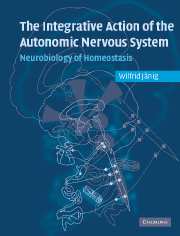Book contents
- Frontmatter
- Contents
- Foreword
- Preface
- List of abbreviations
- Introduction
- Part I The autonomic nervous system: functional anatomy and visceral afferents
- Chapter 1 Functional anatomy of the peripheral sympathetic and parasympathetic nervous system
- Chapter 2 Visceral afferent neurons and autonomic regulations
- Part II Functional organization of the peripheral autonomic nervous system
- Part III Transmission of signals in the peripheral autonomic nervous system
- Part IV Central representation of the autonomic nervous system in spinal cord, brain stem and hypothalamus
- References
- Index
Chapter 2 - Visceral afferent neurons and autonomic regulations
Published online by Cambridge University Press: 10 August 2009
- Frontmatter
- Contents
- Foreword
- Preface
- List of abbreviations
- Introduction
- Part I The autonomic nervous system: functional anatomy and visceral afferents
- Chapter 1 Functional anatomy of the peripheral sympathetic and parasympathetic nervous system
- Chapter 2 Visceral afferent neurons and autonomic regulations
- Part II Functional organization of the peripheral autonomic nervous system
- Part III Transmission of signals in the peripheral autonomic nervous system
- Part IV Central representation of the autonomic nervous system in spinal cord, brain stem and hypothalamus
- References
- Index
Summary
The brain continuously receives messages from internal organs of the body. These afferent messages are neuronal, hormonal, chemical and physical in nature (see Figure 1). The continuous afferent feedback to the brain confers information about the state of internal organs (e.g., the degree and composition of filling of the gastrointestinal tract), the state of parameters regulated homeostatically (e.g., the level of systemic arterial blood pressure; the concentration of glucose, oxygen and bicarbonate in the blood; the size of fat stores by the concentration of leptin), the activity of endocrine glands (by the concentration of circulating hormones secreted by these glands) and the state of peripheral protective mechanisms of the body (e.g., by activity in nociceptive afferents, by signals from immune tissues [cytokines acting directly on the brain or indirectly via vagal afferents]). The multiple afferent feedback signals to the brain from various organs and tissues of the body are essential to achieve the precision of the homeostatic short- and long-term regulations in which the autonomic nervous systems are involved. This afferent (sensory) feedback connects to all levels of the autonomic motor hierarchy, to the centers of the cerebral hemispheres, which are responsible for conscious sensations and cognitive inputs to the motor hierarchy, and to the behavioral state system (Swanson 2000, 2003; see Introduction and Figure 2; see Subchapters 11.4 and 11.6).
Details about these regulations and the functional specificity of the afferent signals with respect to the autonomic regulations will be discussed in Part III of this book.
- Type
- Chapter
- Information
- Integrative Action of the Autonomic Nervous SystemNeurobiology of Homeostasis, pp. 35 - 84Publisher: Cambridge University PressPrint publication year: 2006
- 3
- Cited by



